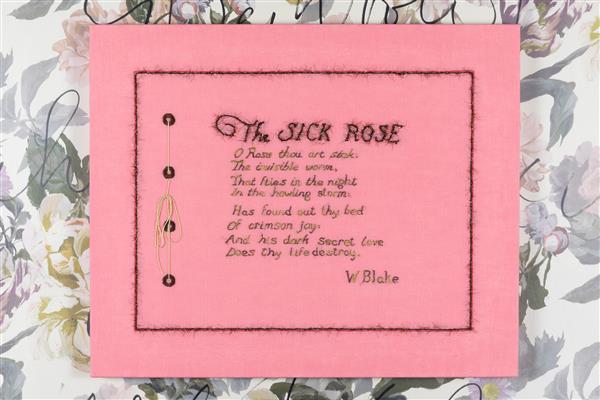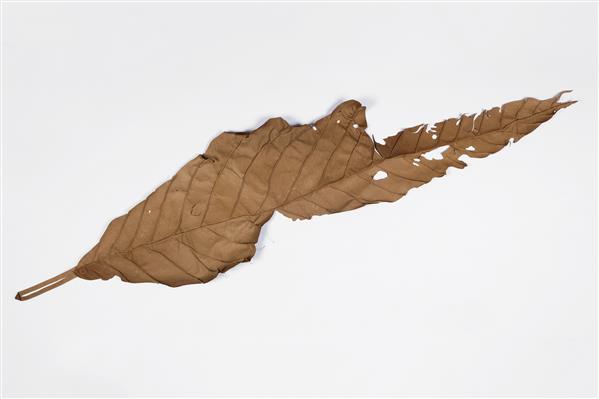The Sick Rose
Elaine Reichek
hand embroidery on linen
42.5 × 52.1 cm
2016
Acquisition 2019
Inv. No. 0410
Literary experts and rock ‘n’ roll icons alike are obsessed with William Blake's “The Sick Rose.” The fascination of this supposedly simple poem lies in the unsettling, slightly irritating appeal of a few lines:
O Rose thou art sick.
The
That flies in the night
In the howling storm:
Has found out thy bed
Of crimson joy:
And his dark secret love
Does thy life destroy.
The poem from Blake's Songs of Innocence and Experience is one of the most famous verses in English literature. It has been set to music by Benjamin Britten and Michael Nyman, and interpreted by Allan Ginsberg. It has inspired Patti Smith, Bob Dylan and Jim Morrison. The hero of Jim Jarmusch's Western Dead Man, a simple accountant, is believed to be a reincarnation of William Blake by the Native American
Blake, a trained engraver, experimented with techniques combining text and images. He invented a new printing technique, relief etching, which allowed him to combine type and illustration on a single metal plate, revolutionizing the printing process.
Language and image also define the work of New York artist Elaine Reichek (1943). Formally and conceptually, it is all about needle and thread. The artist embroiders text passages, emblems, patterns, as well as naturalistic motifs on dyed linen, on colorful cotton, and occasionally on paper.
For The Sick Rose, Reichek uses Blake's original typography, including majuscules and the high capitals in the first line. She thus adopts the typeface from the pages of the nineteen (or rather twenty-six poems) in the work, which were first published in 1789. With a thin thread threaded through four holes, Reichek refers to conventions of letterpress printing and to the fact that Blake's poetry cycle was produced as a bound illustrated book, a graphic novel avant la lèttre. She uses the black wool thread to write/embroider fringe on all sides, alluding to the technique of drypoint etching; in contrast to the sharp edges of etching, velvety ridged shadows create a soft, painterly accompaniment.
Sophisticated and smart, the works float in limbo between the Gutenberg Galaxy and the Internet Age. Reichek demonstrates how to liberate the textile – as material, as technique, and as medium – from the stigma of craft, and uses a technique considered to be inherently feminine as an analytical tool. Reichek combines visual art and literature, music and theater, philosophy, history, and stories from all eras into eclectic arrangements, examining, for example, the archetypal figures from ancient myths and their representation. She is always keeping an eye on contemporary society and politics, role relations, and feminism.
Whether by hand or machine: sewing, embroidery and weaving dictates its own measured pace. It is slower than handwriting or the computer, and more complex, because the method of pulling through threads always gives a front and a back. Everything has two sides, is clearly legible or a mysterious camouflage.
Brigitte Huck, 2021 (translation: Virginia Dellenbaugh)
Exhibitions
Wallpaper #4, evn sammlung, Maria Enzersdorf, 2020
Publications
Wallpaper #4, Vienna 2021, p. 30 ff (s. p.)

